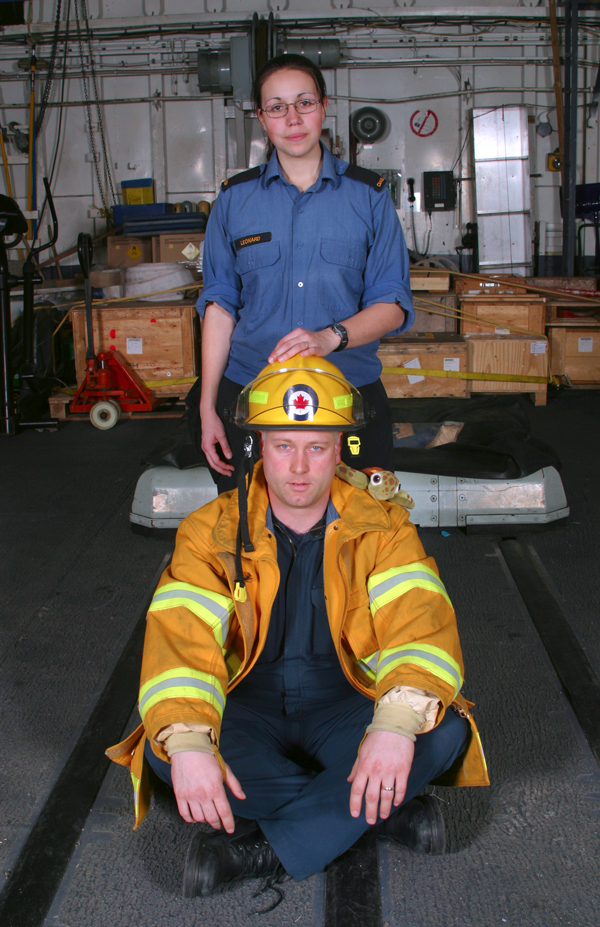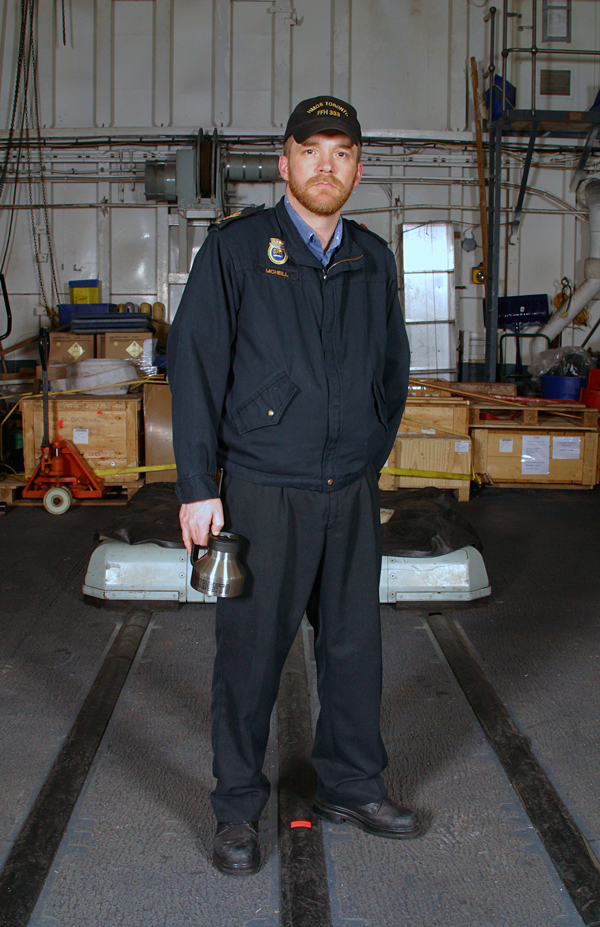Survey
Prefix ICA
June 19, 2008
By Chantal Rousseau
In the spring of 2005, multi-media artist Andrew Wright participated in the Canadian Forces Artists Program (C.F.A.P.) in a three-week tour aboard Her Majesty’s Canadian Ship (H.M.C.S.) Toronto, a naval frigate. Administered through The Department of National Defense, this program was created in 2001 and encourages Canadian artists to observe and document daily life in the armed forces. Survey aligns a series of photographs and videos documenting Wright’s experience with the C.F.A.P. along with more recent videos made using homemade rockets.
The tradition of war art in Canada began with 1916’s First World War when Lord Beaverbrook – formerly Max Aitken – established the Canadian War Memorials Fund. The fund hired Canadian and international artists to document Canada’s involvement until loss of funding in 1919. The decommissioned program was reactivated in 1942 as the Canadian War Records Program for the duration of the Second World War. Twenty years later, in 1968, the Canadian Armed Forces’ Civilian Artists Program was created to provide civilian access / documentation of the military and military life, both home and abroad. The program was discontinued in 1995 due to a lack of funding and was reinstated in 2001 as the C.F.A.P.
The context and history of the various Canadian war art programs are embedded with propagandist overtones that celebrate the military. How does Wright’s series of works from H.M.C.S. fit into this agenda? His ambivalence towards his own participation is evident in the seemingly objective documentary approach to the project. He presents what he sees, whom he meets, and what goes on with a definite air of detachment – his goal is to not present didactic messages. However, the political undertones cannot be dismissed. Wright leaves it up to the viewer to decide how they wish to approach his documents.
H.M.C.S. Toronto was built as a helicopter-carrying vessel, but the helicopters are noticeably absent. This ship, abandoned of its original purpose, is an indication of how military funding works within Canada: the ship is powered, manned, but is now assisting in operations that have little to do with its intended function. Canada’s current military maritime helicopters, the Sea Kings, crash often, a depressing and frightening fact. The Department of National Defense has been engaged in a costly, 25-year long venture attempting to replace these old helicopters with different models. It has not been an easy process; according to the Canadian American Strategic Review, the first new shipboard helicopter wouldn’t be arriving until mid-2008.[1] In what will likely be a very slow replacement procedure, the Sea Kings will continue to operate on those vessels that still have them.[2] Choosing to focus on the empty space – and using it as an extemporaneous studio - Wright calls attention to this history and current reality. The title of one photograph, Empty Sea King Helicopter Hangar Aboard H.M.C.S. Toronto, North Atlantic, 2005 (2008) further underscores this point.
While touring on H.M.C.S. Toronto, Wright documented the ship, the personnel, and their training drills. The empty helicopter hangar became the subject of several photographs, a makeshift studio for the duration of his tour, and a backdrop for portraits he took of the crew. We can compare Wright’s strategy of presenting these seemingly flat and detached images of H.M.C.S. and her crew as a counter strategy - differentiating them from the heroic imagery that is found in traditional war art and contemporary military advertisement. Wright, with full approval from the Department of National Defense, was given the opportunity to create subjective representations of the military and, interestingly, was given no guidelines as to what he should portray. This left Wright asking himself, “How do I respond to this situation?” and when relating his C.F.A.P. experience, Wright described how he befriended the crew.[3] Although he started working with the C.F.A.P. with an expectation, and even desire, to react critically towards the military, that inclination was compromised by his growing awareness that the crew were real people just doing their jobs.[4]
With his series from the H.M.C.S., Wright hopes to articulate a larger issue regarding the politics of war, situating his work in the grey area that envelopes individual ethics and agency.[5] Wright’s portraits of the crewmembers aboard H.M.C.S. Toronto expose the contradictions present in attempts to support individuals while also providing critical responses to the actions that those same individuals are asked to carry out. Whether intentionally or not, C.F.A.P. functions as a parallel to recent military practices that embed journalists in war zones. Both strategies tend to work to the military’s advantage as there is a clear bias towards generating a sympathetic bond through human interest reporting while holding the overarching politics for the war at a distance. It is on this troubling and complicated axis that Wright’s H.M.C.S. work rests.
In his narratively ambiguous and aurally rich video works, Casualty in the Fridge Flats (2008) and Warning Shots (2008), Wright records training drills on the ship. These works expose the varying and collapsing layers of reality that are present in both truthful media representations and the film industry’s adaptation and reinterpretation of that same reality. The drill itself is a simulated event, yet, as argued in Jean Baudrillard’s third order of simulacra - the military drill replaces the real on many levels.[6] The language and imagery of Wright’s video footage - bursts of gunfire over the Atlantic – recall video games and television footage akin to the first Gulf War. Televised war is a format that most of us accept as our sole access to foreign conflict. In writing about this conflation of reality and imaginary in war imagery, Susan Sontag notes, “Something becomes real . . . by being photographed. But a catastrophe that is experience will often seem eerily like its representation . . . unreal, surreal, or like a movie." [7] Andrew Wright moves away from Hollywood emotionalism in an effort to let viewers question and resolve their own understandings of reality and truth in war.
Wright’s series from the H.M.C.S., more documentary in nature than his previous work, faces similar issues in the mediation of imagery and systems of perception. Untitled Rocket Launches (2007) is a recent example of Wright’s work that uses machines to generate imagery and simultaneously highlight these technologies as image generators. While Wright’s past work involved such technologies as the camera obscura and camera lucida, in Untitled Rockets Launches, Wright turns towards contemporary technology - combining homemade rockets with miniature video cameras to collect data, broadcast it on radio waves, and then record the resulting imagery on his computer. The three projected videos present dizzying aerial views of approaching landscapes as each rocket speeds towards the ground - reminiscent of early military attempts to record visuals from missiles.
Survey indicates a technological measuring, a gathering of information, and the myriad ways in which data is presented. The exhibition asks that we question the historical function of Canadian war art as we move towards sensitive and intelligent strategies of portrayal that are so necessary in our present social climate.
Chantal Rousseau, 2008
[1] Stephen Priestly, “Politics, Procurement Practices, and Procrastination: The Quarter-Century Sea King Helicopter Replacement Saga,” Canadian Defense Procurement, July 2004. CASR Online 3 June 2008. http://www.sfu.ca/casr/ft-mhp1.htm.
[2] Ibid.
[3] Personal Communication with Andrew Wright. May/June, 2008.
[4] Ibid.
[5]Ibid.
[6] Jean Baudrillard, Simulacra and Simulation. Michigan: University of Michigan Press, 1996.
[7] Regarding the Pain of Others Susan Sontag, New York: Picador, 2003. 21-2.






